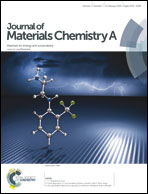Superior electric double layer capacitors using micro- and mesoporous silicon carbide sphere†
Abstract
Three-dimensional silicon carbide-based frameworks with hierarchical micro and mesoporous structures (MMPSiC) are prepared by employing the template method and carbonization reaction via the aerosol-spray drying method. The mesopores are generated by the self-assembly of a structure-directing agent, while the micropores are derived from the partial evaporation of Si atoms during the carbonization process. MMPSiC has a unique three-dimensionally interconnected micro and mesoporous network; it also exhibits a faster ion-transport behavior and a larger utilization of the surface area of the electric double-layer capacitors. MMPSiC shows a high-charge storage capacity, with a specific capacitance of 253.7 F g−1 in 1 M Na2SO4 aqueous electrolyte at a scan rate of 5 mV s−1. In addition, a specific capacitance of 40.3 F g−1 is measured in the 3-ethyl-3-methylimidazolium bis(trifluorosulfonyl)imide ionic-liquid electrolyte at a scan rate of 5 mV s−1, with an energy density of 68.56 W h kg−1; and ∼98.4% specific capacitance being retained over 20 000 cycles. Such a high supercapacitor performance may arise from a synergistic effect ensured by the dual-pore system, which can provide a large accessible surface area for ion transport/charge storage by the mesopores and a continuous increase of charge accommodation by micropores. These encouraging results demonstrate the great potential of MMPSiC as high-performance electrode materials for supercapacitors.


 Please wait while we load your content...
Please wait while we load your content...